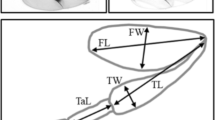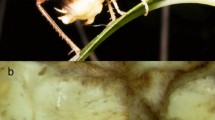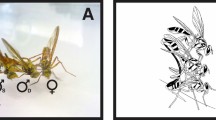Abstract
Reproductive success, copulation success, and mating success were measured for a population of male dragonflies,Orthetrum japonicum. Copulation success explained the greatest variation in reproductive success. The proportion of copulations followed by oviposition was positively correlated with the number of oviposited eggs per mating. Directional selection on four morphological characters was estimated. The effect of selection on correlated traits was comparable to that of direct selection. Directional selection varied between traits and between episodes in a single trait. The probability that the observed directional selection on the four morphological traits was expected under the condition of the selective neutrality of traits was not smaller than 5%.
Similar content being viewed by others
References
Anholt, B. R. (1991) Measuring selection on a population of damselflies with a manipulated phenotype.Evolution 45: 1091–1106.
Arnold, S. J. and M. J. Wade (1984a) On the measurement of natural and sexual selection: theory.Evolution 38: 709–719.
Arnold, S. J. and M. J. Wade (1984b) On the measurement of natural and sexual selection: applications.Evolution 38: 720–734.
Edgington, E. S. (1995)Randomization tests, 3rd edn. Marcel Dekker, New York.
Fincke, O. (1984a) Sperm competition in the damselfly,Enallagma hageni (Odonata: Coenagrionidae): benefits of multiple mating to males and females.Behavioral Ecology and Sociobiology 14: 235–240.
Fincke, O. (1984b) Giant damselflies in a tropical forest: reproductive biology ofMegaloprepus coerulatus with notes on Mecistogaster (Odonata: Pseudostigmatidae).Advances in Odonatology 2: 13–27.
Fincke, O. (1985) Alternative mate-finding tactics in a non-territorial damselfly (Odonata: Coenagrionidae).Animal Behaviour 33: 1124–1137.
Fincke, O. (1986) Lifetime reproductive success and the opportunity for selection in a nonterritorial damselfly (Odonata: Coenagrionidae).Evolution 40: 791–803.
Higashi, K., K. Ubukata and Y. Tsubaki (1987)Dragonfly mating systems.Tokai Univ. Press, Tokyo, (in Japanese)
Kasuya, E., Y. Mashima and J. Hirokawa (1987) Reproductive behavior of the dragonfly,Orthetrum japonicum. Journal of Ethology 5: 105–113.
Kasuya, E., K. Edanami and I. Ohno (1997) Territorial conflicts in males of the dragonfly,Orthetrum japonicum (Odonata: Libellulidae): The role of body size.Zoological Science 14: 505–509.
Koenig, W. D. and S. S. Albano (1987) Lifetime reproductive success, selection and the opportunity for selection in the white-tailed skimmer Plathemis lydia.Evolution 41: 22–36.
Lande, R. and S. J. Arnold (1983) The measurement of selection on the correlated characters.Evolution 37: 1210–1226.
McVey, M. E. (1988) The opportunity for sexual selection in the dragonflyErythemis simplicicollis. pp. 44–58. In T. H. Clutton-Brock (ed.)Reproductive success. Univ. Chicago Press.
McVey, M. E. and B. J. Smittle (1984) Sperm precedence in the dragonflyErythemis simplicicollis.Journal of Insect Physiology 30: 619–628.
Miller, P. L. (1983) The duration of copulation correlates with other aspects of mating behavior inOrthetrum chrysostigma (Burmeister) (Anisoptera: Libellulidae).Odonatologica 12: 227–238.
Reeve, H. K. and L. Keller (1995) Partitioning of reproductive success in mother-daughter versus sibling associations: a test of optimal skew theory.American Naturalist 145: 119–132.
Siva-Jothy, M. T. (1984) Sperm competition in the family Libellulidae with special reference toCrocothemis erythraea andOrthetrum cancellatum.Advances in Odonatology 2: 195–207.
Siva-Jothy, M. T. and Y. Tsubaki (1994) Sperm competition and sperm precedence in the dragonflyNannophya pygmaea.Physiological Entomology 19: 363–366.
Sutherland, W. J. (1985) Chance can produce a sex difference in variance in mating success and explain Bateman’s data.Animal Behaviour 33: 1349–1352.
Tsubaki, Y. and T. Ono (1987) Effect of age and body size on the male territorial system of the dragonfly,Nannophya pygmaea Rambur.Animal Behaviour 35: 518–525.
Waage, J. (1979) Dual function of the damselfly penis: Sperm removal and transfer.Science 203: 916–918.
Waage, J. (1983) Sperm competition and the evolution of odonate mating systems, pp. 251–290. In R. L. Smith (ed.)Sperm competition and the evolution of animal mating systems. Academic Press, New York.
Author information
Authors and Affiliations
Corresponding author
Rights and permissions
About this article
Cite this article
Kasuya, E., Edanami, K. & Ohno, I. Selection and reproductive success in males of the dragonfly,Orthetrum japonicum (Odonata: Libellulidae). Res Popul Ecol 39, 113–119 (1997). https://doi.org/10.1007/BF02765256
Received:
Accepted:
Issue Date:
DOI: https://doi.org/10.1007/BF02765256




